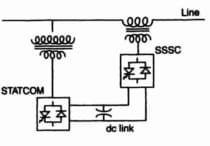 |
| HVDC/HVE |
1. Cloud formation theory are_______.
a. Simpson's Theory
b. Reynolds
c. Mason's Theory
d. Wilson Theory
e. All of above
2. The cloud and the ground form 2 plates of an extremely large capacitor and the dielectric medium is air .The earth is positively charged by induction if air between the cloud and earth break down lightning discharge will occur_________.
a. True
b. False
3. Types of lightning arrestor___________.
a. Multi gap Arrestor
b. Expulsion Type Arrestor
c. Valve type Arrestor
d. Metal oxide Arrestor
e. All of Above
4. The metal oxide surge arrester__________.
a. It eliminates the risk of spark over and also the risk of shock to the system when the gaps break down
b. It eliminates the need of voltage grading system
c. At the normal operating condition, the leakage current in the ZnO is very low as compared to other diverters
d. There is no power follow current in ZnO diverter. It has high energy absorbing capability.
e. All of above
5. Mention the different theories of charge formation., and__________.
a. Simpson’s theory
b. Reynolds’s theory
c. Mason’s theory
d. all of above
6. Types of Power frequency test in testing of insulator___________.
a. Dry Flash over test
b. Wet flash over test
c. Dry and wet withstand test
d. All of above
7. Type of Power frequency test in testing of bushing_________.
a. Power Factor Test
b. Partial Discharge Test
c. Visible Discharge Test
d. All of above
8. Need of H V laboratory________.
a. to find dielectric strength of Solid Liquid and gas insulating material
b. to find Electrical interference in transmission line
c. Testing of electrical Apparatus
d. All of above
9. The lightning Arrester is conducted________.
a. in Series with line
b. between line and earth
c. to a pole near the line
d. to circuit breaker
10. A lightning arrestor is usually located nearer to _______.
a. busbar
b. transformer
c. circuit breaker
d. isolator
11. Which test is conducted to confirm the withstanding capabilities of insulation?
a. One minute power frequency withstand test
b. Lightning impulse withstand test
c. Switching impulse withstand test
d. All of these
12. The voltage at which electrical stress in the insulation makes the insulator to fail is_______.
a. Withstand voltage
b. Impulse voltage
c. Disruptive discharge voltage
d. None of these
13. The cable routine test involves the application of ac voltage which is ________ times rated rated voltage and for approximately _______ minutes.
a. 1/2, 2 minutes
b. 1.5, 3 minutes
c. 2.5, 10 minute
d. 10, 50 minute
14. Impulse tests are performed on transformers________.
a. To determine insulation ability against transient voltages
b. To test the moisture content in fuel
c. Both of these
d. All of these
15. The first step of transformer Impulse testing is to_______.
a. Apply an impulse whose magnitude equals 0.75 times the BIL
b. Apply a chopped impulse whose magnitude is 2 times the BIL
c. Apply a full wave impulse whose magnitude is 1.19 times the BIL
d. Apply a full impulse whose magnitude is 0.8 times the BIL
16. Generally _____________ are avoided in construction of impulse measuring voltage dividers because they ___________.
a. Capacitors, might posses stray capacitance
b. Inductors, can induce stray capacitance
c. Capacitors, carry capacitive impedance
d. Inductors, are very expensive
17. Test conducted on insulators_________.
a. Power Frequency Test
b. Impulse Test
c. All of Above
d. None of Above
18. Commonly used insulator in transmission line tower_________.
a. Pin Type
b. Suspension Type
c. String Type
d. All of above
19. Layout of H V laboratory arrangements differ very much from a arrangement in different_________.
a. single equipment to multiple d.c testing program
b. a.c. testing program
c. impulse testing program
d. All of above
20. Classification of High Voltage Laboratories, depending on the purpose for which they are intended and the resources (finances) available, can be classified into four types.
a. Small laboratories
b. Medium size laboratories
c. Large general purpose laboratories
d. UHV laboratories
e. All of above





0 Comments
If you have any doubt, feel free to ask.